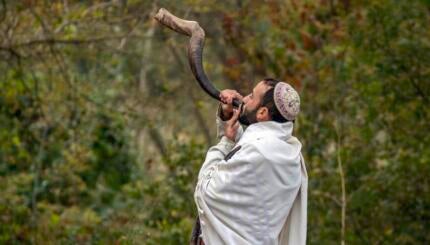It has been said that we grieve because we love. I said it myself in an essay a little over a year ago, written while I was deep in mourning for my husband Burt. Last week, as I sat with my community on the night of Tisha B’Av, the summertime fast mourning the destruction of the two ancient Temples in Jerusalem, it struck me that the inverse is also and perhaps even more true — we love because we grieve.
We gathered in the darkening synagogue courtyard, amid the smoking ruins of the Temple of our hopes, raw and vulnerable, to share our distress and to chant from the Book of Lamentations, which begins with the single, searing word: Eicha. How! A cry of disbelief in the face of unimaginable disaster. How could all this have happened? How could we have come to this? How could so much of what we have revered and sought and taken for granted come crashing down?
In the depths of grief, it’s hard to imagine we’ll ever feel something other than this pain, this constriction, this emptiness. But grief, like all strong emotions, flows and ebbs in oceanic waves. When we dive beneath those waves and let the feelings wash over us, they cleanse and heal, buoying us naturally back to the surface, carrying us toward shore. Fighting the waves, struggling against the current, we sink.
Clearly our ancestors didn’t mean to languish forever in the ashes of despair. Sometime after the destruction of the first Jerusalem Temple in 587 BCE, a joyful custom arose, coinciding with the grape harvest and the final planting of the year. The Mishnah records that on the full moon of Av, a mere six days after the national fast day mourning the Temple’s destruction, young women would dress one another alluringly in white and go out to dance in the vineyards, seeking to attract husbands and start families. Later, most likely after the destruction of the second Temple in 70 CE, a legend emerged that the messiah, harbinger of peace, redemption and repair, would be born on that very date of disaster, the ninth of Av.
With your help, My Jewish Learning can provide endless opportunities for learning, connection and discovery.
This radical pivot from grief to joy and love might engender a case of spiritual whiplash if it weren’t so psychologically astute. Our ancestors sensed that, having scraped bottom, we would need to rise back into life, to allow the energy liberated by our grieving to express itself positively in the world.
Burt died on a brilliantly sunny Shabbat morning. The shock of his death, even though expected, ripped through me as if a limb had been torn away. After his breathing stopped, I wept and wailed at his bedside. Then I got up and opened the blinds that had been closed for weeks to quiet and dim the room. As the light streamed in, beloved friends arrived to help hold this moment of profound transition. We told stories, sobbed and laughed, and sang and sang. The waves of grief rose and fell and rose again. I felt the room breathing.
It’s strange how, in the most vivid and essential moments of life, weeping turns so swiftly to laughter, laughter to gut-wrenching sobs. As the reality of loss seeps in, the mundane takes over, bringing with it a kind of frozen numbness. During this past year of mourning, I’ve often felt flat and empty, merely going through the motions of my days. Then a poignant moment of connection with a friend, the scent of a blossoming rose or the simple pleasure of warm water on my skin reawakens me to life. Tears come. I’m flooded with gratitude for the people who’ve supported and consoled me, grateful for life itself.
These days, for many of us, the losses and deaths and disappointments are coming so thick and fast that it’s hard to give in to the tidal rhythms of grief, to dive beneath its crashing waves. It feels as if we’ll drown. The psalmist’s hyperbolic claim rings hollow: “At night you lie down weeping, but in the morning, a cry of joy.”
Perhaps it was the challenge of emerging from depths of their own grief that spurred the rabbis of old to designate the seven Shabbats following Tisha b’Av as Sheva d’Nechemta, the “Seven of Consolation.” On each of these Sabbaths, the weekly Torah portion is accompanied by selections from the Book of Isaiah, some of the most moving words of hope and healing in all of the biblical canon. They reach out across the millennia, speaking to our battered hearts: Nachamu, nachamu ami. Comfort, comfort, O my people!
Like dear friends, they come to embrace us in our times of grief and hopelessness, alchemizing the anguish of loss through the power of love, pointing us toward Rosh Hashanah and the mythic birthday of the world seven weeks hence, the possibility of a cosmic reboot. This year, the lovefest of Tu B’Av coincides with the first Shabbat of Consolation, reminding us that the pain of loss doesn’t last forever and inviting us to come together, to hold our wounded hearts gently as we lead one another into the dance.
This article initially appeared in My Jewish Learning’s Shabbat newsletter Recharge on August 9, 2025. To sign up to receive Recharge each week in your inbox, click here.



